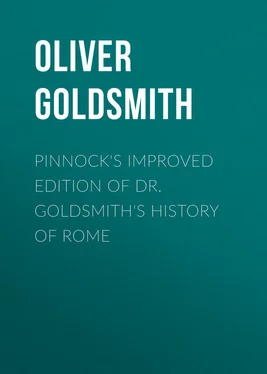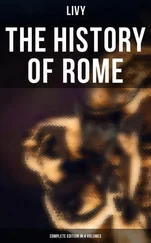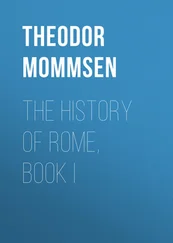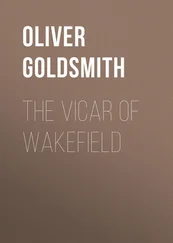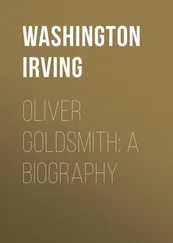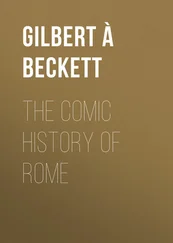Oliver Goldsmith - Pinnock's improved edition of Dr. Goldsmith's History of Rome
Здесь есть возможность читать онлайн «Oliver Goldsmith - Pinnock's improved edition of Dr. Goldsmith's History of Rome» — ознакомительный отрывок электронной книги совершенно бесплатно, а после прочтения отрывка купить полную версию. В некоторых случаях можно слушать аудио, скачать через торрент в формате fb2 и присутствует краткое содержание. Издательство: Иностранный паблик, Жанр: foreign_antique, foreign_prose, на английском языке. Описание произведения, (предисловие) а так же отзывы посетителей доступны на портале библиотеки ЛибКат.
- Название:Pinnock's improved edition of Dr. Goldsmith's History of Rome
- Автор:
- Издательство:Иностранный паблик
- Жанр:
- Год:неизвестен
- ISBN:нет данных
- Рейтинг книги:4 / 5. Голосов: 1
-
Избранное:Добавить в избранное
- Отзывы:
-
Ваша оценка:
- 80
- 1
- 2
- 3
- 4
- 5
Pinnock's improved edition of Dr. Goldsmith's History of Rome: краткое содержание, описание и аннотация
Предлагаем к чтению аннотацию, описание, краткое содержание или предисловие (зависит от того, что написал сам автор книги «Pinnock's improved edition of Dr. Goldsmith's History of Rome»). Если вы не нашли необходимую информацию о книге — напишите в комментариях, мы постараемся отыскать её.
Pinnock's improved edition of Dr. Goldsmith's History of Rome — читать онлайн ознакомительный отрывок
Ниже представлен текст книги, разбитый по страницам. Система сохранения места последней прочитанной страницы, позволяет с удобством читать онлайн бесплатно книгу «Pinnock's improved edition of Dr. Goldsmith's History of Rome», без необходимости каждый раз заново искать на чём Вы остановились. Поставьте закладку, и сможете в любой момент перейти на страницу, на которой закончили чтение.
Интервал:
Закладка:
14. The Forum, or place of public assembly, was situated between the Palatine and Capitoline hills. It was surrounded with temples, basilicks, 22 22 Basilicks were spacious halls for the administration of justice.
and public offices, and adorned with innumerable statues. 23 23 It is called Templum by Livy; but the word templum with the Romans does not mean an edifice, but a consecrated inclosure. From its position, we may conjecture that the forum was originally a place of meeting common to the inhabitants of the Sabine town on the Quirinal, and the Latin town on the Palatine hill.
On one side of this space were the elevated seats from which the Roman magistrates and orators addressed the people; they were called Rostra, because they were ornamented with the beaks of some galleys taken from the city of Antium. In the centre of the forum was a place called the Curtian Lake, either from a Sabine general called Curtius, said to have been smothered in the marsh which was once there; or from 24 24 See Chap. XII. Sect. V. of the following History.
the Roman knight who plunged into a gulf that opened suddenly on the spot. The celebrated temple of Ja'nus, built entirely of bronze, stood in the Forum; it is supposed to have been erected by Numa. The gates of this temple were opened in time of war, and shut during peace. So continuous we're the wars of the Romans, that the gates were only closed three times during the space of eight centuries. In the vicinity stood the temple of Concord, where the senate frequently assembled, and the temple of Vesta, where the palla'dium was said to be deposited.
15. Above the rostra was the Senate-house, said to have been first erected by Tullus Hostilius; and near the Comitium, or place of meeting for the patrician Curiæ. 25 25 See the following chapter.
This area was at first uncovered, but a roof was erected at the close of the second Pu'nic war.
16. The Cam'pus Mar'tius, or field of Mars, was originally the estate of Tarquin the Proud, and was, with his other property, confiscated after the expulsion of that monarch. It was a large space, where armies were mustered, general assemblies of the people held, and the young nobility trained in martial exercises. In the later ages, it was surrounded by several magnificent structures, and porticos were erected, under which the citizens might take their accustomed exercise in rainy weather. These improvements were principally made by Marcus Agrippa, in the reign of Augustus. 17. He erected in the neighbourhood, the Panthe'on, or temple of all the gods, one of the most splendid buildings in ancient Rome. It is of a circular form, and its roof is in the form of a cupola or dome; it is used at present as a Christian church. Near the Panthe'on were the baths and gardens which Agrippa, at his death, bequeathed to the Roman people.
18. The theatres and circi for the exhibition of public spectacles were very numerous. The first theatre was erected by Pompey the Great; but the Circus Maximus, where gladiatorial combats were displayed, was erected by Tarquinus Priscus; this enormous building was frequently enlarged, and in the age of Pliny could accommodate two hundred thousand spectators. A still more remarkable edifice was the amphitheatre erected by Vespasian, called, from its enormous size, the Colosse'um.
19. Public baths were early erected for the use of the people, and in the later ages were among the most remarkable displays of Roman luxury and splendour. Lofty arches, stately pillars, vaulted ceilings, seats of solid silver, costly marbles inlaid with precious stones, were exhibited in these buildings with the most lavish profusion.
20. The aqueducts for supplying the city with water, were still more worthy of admiration; they were supported by arches, many of them a hundred feet high, and carried over mountains and morasses that might have appeared insuperable. The first aqueduct was erected by Ap'pius Clo'dius, the censor, four hundred years after the foundation
of the city; but under the emperors there were not less than twenty of these useful structures, and such was the supply of water, that rivers seemed to flow through the streets and sewers. Even now, though only three of the aqueducts remain, such are their dimensions that no city in Europe has a greater abundance of wholesome water than Rome.
21. The Cloa'cæ, or common sewers, attracted the wonder of the ancients themselves; the largest was completed by Tarquin the Proud. The innermost vault of this astonishing structure forms a semicircle eighteen Roman palms wide, and as many high: this is inclosed in a second vault, and that again in a third, all formed of hewn blocks of pepenno, fixed together without cement. So extensive were these channels, that in the reign of Augustus the city was subterraneously navigable.
22. The public roads were little inferior to the aqueducts and Cloa'cæ in utility and costliness; the chief was the Appian road from Rome to Brundu'sium; it extended three hundred and fifty miles, and was paved with huge squares through its entire length. After the lapse of nineteen centuries many parts of it are still as perfect as when it was first made.
23. The Appian road passed through the following towns; Ari'cia, Fo'rum Ap'pii, An'xur or Terraci'na, Fun'di, Mintur'næ, Sinue'ssa, Cap'ua, Can'dium, Beneven'tum, Equotu'ticum, Herdo'nia, Canu'sium, Ba'rium, and Brundu'sium. Between Fo'rum Ap'pii and Terraci'na lie the celebrated Pomptine marshes, formed by the overflowing of some small streams. In the flourishing ages of Roman history these pestilential marshes did not exist, or were confined to a very limited space; but from the decline of the Roman empire, the waters gradually encroached, until the successful exertions made by the Pontiffs in modern times to arrest their baleful progress. Before the drainage of Pope Sixtus, the marshes covered at least thirteen thousand acres of ground, which in the earlier ages was the most fruitful portion of the Italian soil.
Questions for Examination .
1. When was Rome founded?
2. What ceremonies were used in determining the pomcerium?
3. How was the comitium consecrated?
4. What was the first addition made to Rome?
5. What was the next addition?
6. Into what tribes were the Romans divided?
7. What were the hills added in later times to Rome?
8. Had the Romans any buildings north of the Tiber?
9. When did Rome become a magnificent city?
10. What was the extent of the city?
11. How was the city divided?
12. Which was the most remarkable of the seven hills?
13. What buildings were on the Capitoline hill?
14. What description is given of the forum?
15. Where was the senate-house and comitium?
16. What use was made of the Campus Martius?
17. What was the Pantheon?
18. Were the theatres and circii remarkable?
19. Had the Romans public baths?
20. How was the city supplied with water?
21. Were the cloacæ remarkable for their size?
22. Which was the chief Italian road?
23. What were the most remarkable places on the Appian road?
CHAPTER IV.
THE ROMAN CONSTITUTION
As once in virtue, so in vice extreme,
This universal fabric yielded loose,
Before ambition still; and thundering down,
At last beneath its ruins crush'd a world. — Thomson .
I. The most remarkable feature in the Roman constitution is the division of the people into Patricians and Plebeians, and our first inquiry must be the origin of this separation. It is clearly impossible that such a distinction could have existed from the very beginning, because no persons would have consented in a new community to the investing of any class with peculiar privileges. We find that all the Roman kings, after they had subdued a city, drafted a portion of its inhabitants to Rome; and if they did not destroy the subjugated place, garrisoned it with a Roman colony. The strangers thus brought to Rome were not admitted to a participation of civic rights; they were like the inhabitants of a corporate town who are excluded from the elective franchise: by successive immigrations, the number of persons thus disqualified became more numerous than that of the first inhabitants or old freemen, and they naturally sought a share in the government, as a means of protecting their persons and properties. On the other hand, the men who possessed the exclusive power of legislation, struggled hard to retain their hereditary privileges, and when forced to make concessions, yielded as little as they possibly could to the popular demands. Modern history furnishes us with numerous instances of similar struggles between classes, and of a separation in interests and feelings between inhabitants of the same country, fully as strong as that between the patricians and plebeians at Rome.
Читать дальшеИнтервал:
Закладка:
Похожие книги на «Pinnock's improved edition of Dr. Goldsmith's History of Rome»
Представляем Вашему вниманию похожие книги на «Pinnock's improved edition of Dr. Goldsmith's History of Rome» списком для выбора. Мы отобрали схожую по названию и смыслу литературу в надежде предоставить читателям больше вариантов отыскать новые, интересные, ещё непрочитанные произведения.
Обсуждение, отзывы о книге «Pinnock's improved edition of Dr. Goldsmith's History of Rome» и просто собственные мнения читателей. Оставьте ваши комментарии, напишите, что Вы думаете о произведении, его смысле или главных героях. Укажите что конкретно понравилось, а что нет, и почему Вы так считаете.
